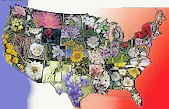New Jersey State Flower

Common Meadow Violet
(Viola sororia)
Adopted in 1913; February 15, 1972 .
The state flower of New Jersey was originally designated as such by a resolution of the Legislature in 1913. Unfortunately the force of resolution ended with the start of the 1914 legislative session, leaving the violet with uncertain status for the next fifty years. In 1963 an attempt was made to have the Legislature "officially" designate the violet as the state flower, but the legislation apparently failed. In 1971, at the urging of New Jersey's garden clubs, legislation more specifically designating the Common Meadow Violet, (Viola sororia,) as the state flower was enacted.
The violet is the state flower for Illinois, New Jersey, Rhode Island and Wisconsin.
New Jersey State Flower: Common Meadow Violet

Viola sororia, known commonly as the Common Blue Violet, is a stemless herbaceous perennial plant that is native to eastern North America. It is known by a number of common names including; Common Meadow Violet, Purple Violet, Woolly Blue Violet, Hooded Violet and Wood Violet.
Self-seeding freely, in lawns and gardens it can become a weed. Cleistogamous seed heads may also appear on short stems late summer, early autumn.
Even though violets are often considered "shy," they are hardy enough to grow in New Jersey fields, lawns, and anywhere they can find warm spring sunshine.
Characteristics of the Common Meadow Violet
The Common Meadow Violet is a perennial plant that flowers during the spring months. The green leaves and purple or violet hued flowers grow on separate stems, which emerge directly from a horizontal, ground-level plant stem called a rhizome. Typically, an individual plant grows to about six inches across and four inches high, with the flowers arranged just above the leaves.
The leaves are generally three inches across and have what might commonly be termed a heart-shape. Typically, the leaves are covered by a fine, hair-like growth. The flowers are less than an inch across, with five soft petals. The center mouth of each flower fades to white. During the summer, after the purple blooms have retreated, the plant produces a second type of flower, which has no petals. These flowers produce seeds, which are soon ejected, canon-like, from the flower pod. This explains why wild patches of the plant commonly extend over wide areas.
Identification of the Common Meadow Violet
- Family: Violet (Violaceae)
- Habitat: woods, meadows, waste areas
- Height: 3-8 inches
- Flower size: 3/4 to 1 inch wide
- Flower color: blue-purple, occasionally white or bicolor
- Flowering time: April to June
- Origin: native
New Jersey Assembly Bill No. 2180
Assembly Bill No. 2180, introduced in the New Jersey General Assembly on February 16, 1971, promoted adoption of the violet (common meadow, Viola sororia) as the New Jersey State Flower. The bill was approved on February 15, 1972.
Chapter 444, Laws of 1971
Approved 2-15-72
ASSEMBLY, No. 2180
Introduced February 16, 1971
By Assemblywoman MARGETTS, Assemblymen VREELAND and COBB
AN ACT designating the violet as the New Jersey State Flower.
BE IT ENACTED by the Senate and General Assembly of the State of New Jersey:
The violet (common meadow, V. sororia) is designated the New Jersey State Flower.
This act shall take effect immediately.
The New Jersey Permanent Statutes
The law designating the violet as the official New Jersey state flower is found in from the New Jersey Permanent Statutes, Title 52, Section 52:9A-2.
TITLE 52. STATE GOVERNMENT, DEPARTMENTS AND OFFICERS.
SECTION 52:9A-2.
52:9A-2. Violet; designation as state flower
The violet (common meadow, V. sororia) is designated the New Jersey State Flower.
L.1971, c. 444, s. 1, eff. Feb. 15, 1972.
Taxonomic Hierarchy: Common Meadow Violet
Kingdom: Plantae - Plants
Subkingdom: Tracheobionta - Vascular plants
Superdivision: Spermatophyta - Seed plants
Division: Magnoliophyta - Flowering plants
Class: Magnoliopsida - Dicotyledons
Subclass: Dilleniidae
Order: Violales
Family: Violaceae - Violet family
Genus: Viola L. - violet
Species: Viola sororia Willd. - common blue violet
State Floral Emblems








